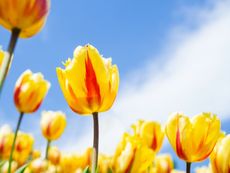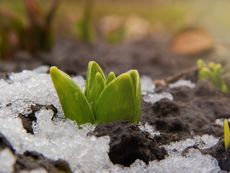Types Of Flower Bulbs - Learn About Different Bulb Types


Plants propagate from many sources. Seeds are the most common way, but they also reproduce through offsets, corms, rhizomes, tubers, and bulbs. Bulbs are underground storage structures that carry both the genetic starting material for the plant but also a food supply to get it going. There are five different types of bulbs but only one true bulb. The different bulb types are more accurately called geophytes and encompass a wide range of plant types.
True Bulb Basics
The true bulb is a layered structure filled with plant carbohydrates with a plant shoot in the core. It has a basal plate where roots grow, fleshy scales or layers, the outer skin, and the shoot at the center flanked by developing bulblets. Common spring bulbs, like daffodils and tulips, are true bulbs.
There are two different types of bulbs that are in the true bulb category.
Tunicate bulbs all have the outer skin or tunic. This papery cover protects the interior scales where the food sources are stored. Tulips are a good example of this type of bulb.
Imbricate bulbs, like lilies, do not have a paper covering. This type of bulb must stay moist prior to planting.
Different Bulb Types
Many underground storage structures are also called bulbs, but they are not true bulbs. These include corms, tubers, and rhizomes. Each of these is also filled with carbohydrate sugars to fuel plant growth and development.

Corms - Corms are similar in appearance to bulbs but are solid inside. Crocosmia grows from corms, which spread rapidly and easily, as do gladiolus, crocus, and freesia.
Gardening tips, videos, info and more delivered right to your inbox!
Sign up for the Gardening Know How newsletter today and receive a free download of our most popular eBook "How to Grow Delicious Tomatoes."

Tubers - A tuber is a swollen stem with growth nodes or eyes. Daylilies and cyclamen are examples of tuber types of flower bulbs. Tubers are propagated by planting a piece of the tuber with several healthy eyes. There are exotic and urbane types of flower bulbs, with a variety suitable for nearly every gardening situation.

Tuberous roots - There are also tuberous roots, like tuberous begonia, which are thickened roots that hold food sources.

Rhizomes - Rhizomes are another of the bulb plant types. They are simply underground stems that also store plant food and can sprout new growth. Common plants having rhizomes are irises. You can see the rhizomes on old stands of iris, as the large roots get pushed up out of the soil. They are easy to pull apart and start new plants.

Bulblets/bulbils - There is another bulb-type structure called a bulblet or bulbil. These are the tiny round organs found growing on the tops of Alliums and related plants.
Bulb Plant Types
Not only flowering plants spring from bulbs and other storage structures. Potatoes come from tubers, bamboo arises from rhizomes, and elephant ear plants have tuberous bulb-like structures. While not technically considered bulbs, hostas are also commonly grouped with other bulbous-type plants.
The most well-known, however, are the flowering types. The wide variety in types of flower bulbs speaks to nature's wisdom in providing variety and adaptability in her plants.

Bonnie Grant is a professional landscaper with a Certification in Urban Gardening. She has been gardening and writing for 15 years. A former professional chef, she has a passion for edible landscaping.
-
 Cheap Fence Ideas For A Pretty And Private Yard
Cheap Fence Ideas For A Pretty And Private YardYou don’t need to spend a fortune to box in your garden. Take these cheap fencing ideas for your garden and budget and run with them.
By Mary Ellen Ellis
-
 How To Attract Cardinals – Get Beautiful Songbirds Flocking To Your Yard
How To Attract Cardinals – Get Beautiful Songbirds Flocking To Your YardThe northern cardinal is a national treasure and a delight to spot in the garden, nesting in shrubbery and flitting between feeders. Discover how to attract this beloved songbird by providing the right food, shelter, and water.
By Melanie Griffiths
-
 Pretty Spring Bulbs For Pollinators
Pretty Spring Bulbs For PollinatorsWhat are the best flowering bulbs for pollinators in spring? Click here to find out.
By Mary Ellen Ellis
-
 Grow An Early Spring Flowering Bulb Lawn
Grow An Early Spring Flowering Bulb LawnWant a lawn that nourishes pollinators, never needs weeding, and grows more beautiful every year? We have the lawn for you. Click for more.
By Caroline Bloomfield
-
 When To Dig Up Bulbs That Bloom In Summer
When To Dig Up Bulbs That Bloom In SummerClick here to learn when to dig up faded summer bulbs of some of the most common ornamentals grown.
By Tonya Barnett
-
 Corms, Tubers, And Bulbs That Are Deer Resistant
Corms, Tubers, And Bulbs That Are Deer ResistantWe love tulips, and so do deer! If you have hungry deer and you hunger for spring blooms, this article should help.
By Amy Grant
-
 Care for Bulbs After Blooming
Care for Bulbs After BloomingIt's tempting to chop down the leaves after you bulbs have bloomed, but you have to resist this urge! Click to learn why.
By Amy Draiss
-
 Best Spring Bulbs for Sun and Shade: Bulbs That Grow in Shade and Full Sun
Best Spring Bulbs for Sun and Shade: Bulbs That Grow in Shade and Full SunBulbs are beautiful harbingers of spring. Most flower bulbs thrive in full sun, but what if you have a shaded landscape? Read on for more.
By Amy Grant
-
 Bulb Life Cycle In Winter: What Bulbs Do For Months Under The Snow
Bulb Life Cycle In Winter: What Bulbs Do For Months Under The SnowDormancy in winter doesn't mean nothing is happening with bulbs. It just means you don't see any growth above the ground. Read on for more.
By Bonnie L. Grant
-
 How To Plant Bulbs In Pots - Lasagna Style
How To Plant Bulbs In Pots - Lasagna StylePlanting bulbs in containers is an easy way to create a gorgeous spring porch arrangement, especially when you use the lasagna method.
By Laura Walters